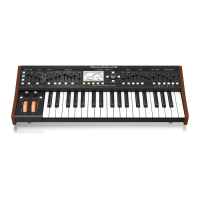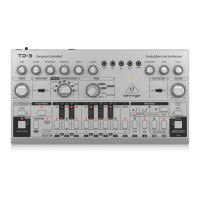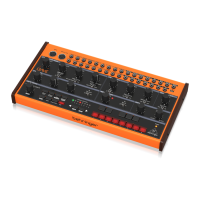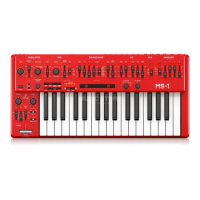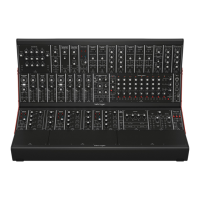76 DeepMind 12 User Manual
• Mono - The same voice is allocated to every note played.
• Mono-2 - The same two voices are allocated to each note played. Voices
are spread in the same way as Unison-2 mode.
• Mono-3 - The same three voices are allocated to each note played.
Voices are spread in the same way as Unison-3 mode.
• Mono-4 - The same four voices are allocated to each note played. Voices
are spread in the same way as Unison-4 mode.
• Mono-6 -The same six voices are allocated to each note played. Voices
are spread in the same way as Unison-6 mode.
• Poly-6 - A single voice is allocated to each note played, but polyphony is
limited to the next available six notes.
• Poly-8 - A single voice is allocated to each note played, but polyphony is
limited to the next available eight notes.
Note: When an even number of voices are used (Unison2/4/6/12, Mono
2/4/6), the voices are spread across the spectrum evenly, which means
the root note is not actually played. However if an odd number of voices
are used, when the voices are spread across the spectrum, then one
voice will be playing the root note.
• UNISON DETUNE - This option is the same as the UNISON DETUNE fader on
the surface. Any changes on the surface will be reected here.
The UNISON DETUNE range is from ±0.0 cents to 50.0 cents (0 to 255), and
the default setting is 0.0 cents (O).
• PRIORITY - When in monophonic mode, or when more notes are played
than there are voices available (due to polyphonic/unison settings), this
mode controls which notes are prioritized.
• Lowest - In lowest note priority, when a newly requested note is lower
in pitch than the notes currently being played, then it will be given
priority and will steal the voice that is playing the highest note.
• Highest - In highest note priority, when a newly requested note is
higher in pitch than the notes currently being played, then it will be
given priority and will steal the voice that is playing the lowest note.
• Last - In this mode the notes are prioritized based on the order in
which they are played. When a newly requested note is triggered while
all voices are playing, it steals the voice used by the note played least
recently. The default PRIORITY setting is Last.
Note: PRIORITY is not available as an option when in POLY CHAIN mode
because excess notes are played on other DeepMind 12 units in the Poly
Chain. (See the CHAIN PARAMETERS MENU).
• ENV-TRIGGER - The envelopes can be triggered in dierent ways. This
allows you to choose a mode from the following options:
• Mono - In this triggering mode, the voice will start its attack stage
from the current envelope level, that is, its last level from the previous
release. The default triggering mode is Mono.
• Retrigger - In this triggering mode, the envelope will be reset to zero
and then start its attack stage.
• Legato - In this triggering mode, the envelope does not re-trigger
when a new note is played. The only time the envelope will start the
attack stage again is once the note is released.
• One-shot - In this triggering mode, the envelope will be reset to zero
and then start its attack stage. Once the decay phase is complete, the
envelope will jump immediately to its release stage (that is, there is no
sustain phase).
• OSC-DRIFT - This option allows you to recreate the oscillator tuning drift
that vintage analog synthesizers have.
As you increase the OSC-DRIFT value, the pitch of the oscillators will be slowly
modulated at random.
OSC-DRIFT is applied to both OSC 1 and OSC 2.
The OSC-DRIFT range is from 0 to 255, and the default setting is 0 (no drift).
• PARAM-DRIFT - This option allows you to recreate the drift that many
parameters in a vintage analog synthesizers have.
As you increase the PARAM-DRIFT value, the drift distances will increase.
Note: The parameters which DRIFT is applied to are:
• OSC1 PITCH MOD, OSC1 PWM, OSC2 PITCH MOD, OSC2 TONE MOD,
• VCF FREQ, VCF RES, VCF ENV DEPTH, VCF LFO DEPTH, VCA ENV DEPTH,
• MOD ENV DEPTH
The PARAM-DRIFT range is from 0 to 255, and the default setting is 0.
• DRIFT-RATE - This controls the RATE at which the OSC-DRIFT and
PARAM-DRIFT operate. It is important to note that each voice has
independent random DRIFT generators for the OSC-DRIFT and the
PARAM-DRIFT, to more closely replicate the characteristics of a vintage
synthesizer.
The rate is controlled by a random timer which generates a ramp between
a multiplier of 1x and a multiplier of 2x the rate set by the DRIFT-RATE
parameter.
The OSC-DRIFT range is from 0 (25 ms-50 ms) to 255 (2.5 s-5.0 s). The default
OSC-DRIFT setting is 0.
To summarize, if the DRIFT-RATE is at 0, each “drift” will be a random time
between 25 and 50 ms, and then the parameter drifts to another random
value. At 255, each “drift” will be a random time between 2.5 s and 5.0 s and
then the parameter drifts to another random value.
5. To exit the VOICE PARAMETERS menu, press the PROG switch to return the
main display, or press POLY EDIT once more to reach the PITCH PARAMETERS
menu.
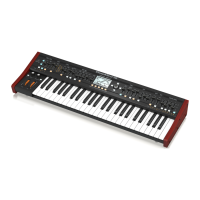
